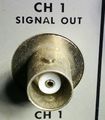BNC connector: Difference between revisions
Jump to navigation
Jump to search
No edit summary |
mNo edit summary |
||
| Line 1: | Line 1: | ||
[[File:Bnc female.jpg|250px|thumb|right|"Female" BNC connector]] | [[File:Bnc female.jpg|250px|thumb|right|"Female" BNC connector]] | ||
'''BNC''' (from ''Bayonet Neill–Concelman'', sometimes erroneously | '''BNC''' (from ''Bayonet Neill–Concelman'', sometimes erroneously referred to as the ''Bayonet Naval Connector'' or the ''Baby N Connector'') is the most common coaxial connector standard for measurement equipment up to 1 GHz. | ||
It was patented in 1951 by Hazeltine Research, Inc. | It was patented in 1951 by Hazeltine Research, Inc. | ||
It is available in different impedances | It is available in different impedances, but 50 Ω is, by far, the most common. | ||
Tektronix gear transitioned from [[UHF connector]]s to BNC connectors in | Tektronix gear transitioned from [[UHF connector]]s to BNC connectors in | ||
Revision as of 15:31, 26 November 2023

BNC (from Bayonet Neill–Concelman, sometimes erroneously referred to as the Bayonet Naval Connector or the Baby N Connector) is the most common coaxial connector standard for measurement equipment up to 1 GHz.
It was patented in 1951 by Hazeltine Research, Inc. It is available in different impedances, but 50 Ω is, by far, the most common.
Tektronix gear transitioned from UHF connectors to BNC connectors in the early to mid-1960's. For some pieces of equipment, a conversion kit was available.
Links
Pictures
-
BNC Female
-
BNC Male

